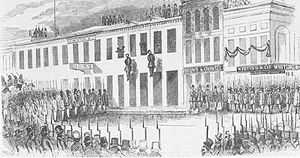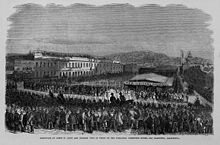- San Francisco Committee of Vigilance
-
The San Francisco Committee of Vigilance was a popular ad hoc organization formed in 1851 and revived in 1856. Their purpose was to rein in rampant crime and government corruption. They were among the most successful organizations in the vigilante tradition of the American Old West.
These militias hanged eight people and forced several elected officials to resign. Each Committee of Vigilance formally relinquished power after three months.
Contents
1851
The 1851 Committee of Vigilance was inaugurated on June 9 with the promulgation of a written doctrine declaring its aims[1] and on June 10, followed up with the hanging of John Jenkins, from Sydney, convicted in a trial organized by the committee of stealing a safe from an office (grand larceny was punishable by death under California law at the time).[citation needed] The June 13 San Francisco Alta printed this statement:
“ WHEREAS it has become apparent to the citizens of San Francisco, that there is no security for life and property, either under the regulations of society as it at present exists, or under the law as now administered; Therefore the citizens, whose names are hereunto attached, do unit themselves into an association for the maintenance of the peace and good order of society, and the preservation of the lives and property of the citizens of San Francisco, and do bind ourselves, each unto the other, to do and perform every lawful act for the maintenance of law and order, and to sustain the laws when faithfully and properly administered; but we are determined that no thief, burglar, incendiary or assassin, shall escape punishment, either by the quibbles of the law, the insecurity of prisons. the carelessness or corruption of the police, or a laxity of those who pretend to administer justice. ” It boasted a membership of 700 and operated parallel to, and in defiance of, the duly constituted city government. Committee members used its headquarters for the interrogation and incarceration of suspects, who were denied the benefits of due process. The Committee engaged in policing, investigating disreputable boarding houses and vessels, deporting immigrants, and parading its militia. In total, four people were hanged by the Committee; one was whipped (a common punishment at that time); fourteen were deported to Australia; fourteen were informally ordered to leave California; fifteen were handed over to public authorities; and forty-one were discharged. The 1851 Committee of Vigilance was dissolved during the September elections, but its executive members continued to meet into 1853.[2] Among those killed were John Jenkens, an Australian from Sydney, accused of burglary, who was hanged on June 10, 1851; James Stuart, also from Sydney, accused of murder, hanged on July 11, 1851; and Samuel Whittaker and Robert McKenzie, associates of Stuart accused of "various heinous crimes", hanged on August 24, 1851. The lynching of Whittaker and McKenzie occurred three days after a standoff between the Committee and the nascent police force trying to protect the prisoners; the Committee nabbed Whittaker and McKenzie after storming the jail during Sunday church services.[3]
The Committee offered a $5,000 reward for the capture of anyone found guilty of arson, and committee members patrolled the streets at night to watch for fires. After these actions were taken, fires in San Francisco diminished noticeably.
1856
 1856 Committee of Vigilance medallion inscribed: "Organized 9th June 1851. Reorganized 14th May 1856. Be Just and Fear Not." The eye symbol was borrowed from Freemasonry, but in its 1856 vigilante context conveyed surveillance as a means of social discipline, not the Masonic meaning of scientific and aesthetic knowledge. Note that Lady Justice is not blindfolded.[2]
1856 Committee of Vigilance medallion inscribed: "Organized 9th June 1851. Reorganized 14th May 1856. Be Just and Fear Not." The eye symbol was borrowed from Freemasonry, but in its 1856 vigilante context conveyed surveillance as a means of social discipline, not the Masonic meaning of scientific and aesthetic knowledge. Note that Lady Justice is not blindfolded.[2]
The Committee of Vigilance was reorganized on 14 May 1856 by many of the leaders from the first one and adopted an amended version of the 1851 constitution.[2] Unlike the earlier Committee, and the vigilante tradition generally, the 1856 Committee was concerned with not only civil crimes but also politics and political corruption.[2] The catalyst for the Committee was a murder, in the guise of a political duel in which James P. Casey shot opposition newspaper editor James King of William. The 1856 Committee was also much larger, claiming 6,000 in its ranks. The 1856 Committee of Vigilance dissolved on 11 August 1856, and marked the occasion with a “Grand Parade.”[2] Political power in San Francisco was transferred to a new political party established by the vigilantes, the People's Party, which ruled until 1867 and was eventually absorbed into the Republican Party. The vigilantes had thus succeeded in their objective of usurping power from the Democratic Party machine that hitherto dominated civic politics in the city.[4] Notable people included William Tell Coleman, Martin J. Burke, San Francisco mayor Henry F. Teschemacher, and San Francisco's first chief of police James F. Curtis.
Vigilante headquarters in 1856 consisted of assembly halls, meeting rooms, a military kitchen and armoury, an infirmary, and prison cells, all of which were fortified with gunny sacks and cannons.[2] Four people were officially executed again in 1856, but the death toll also includes James “Yankee” Sullivan, an Irish immigrant and professional boxer who killed himself after being terrorized and detained in a Vigilante cell.[2][5] The 1856 Committee also engaged in policing, investigations, and secret trials, but it far exceeded its predecessor in audacity and rebelliousness. Most notably, it seized a federal shipment of armaments intended for the state militia and tried the chief justice of the California Supreme Court.[2] The Committee’s authority, however, was bolstered by almost all militia units in the city, including the California Guards.[2]
Controversy
A great deal of historical controversy exists about the vigilance movements. The 1856 hangings of Charles Cora and James Casey, for example, are open to interpretation. Both were hanged as murderers by the Committee of Vigilance: Cora shot dead a U.S. Marshal who had drunkenly insulted his mistress, and Casey killed a rival newspaper editor for publishing an editorial that exposed Casey's criminal record in New York. Cora's first trial had ended in a hung jury, and there were rumors that the jury had been bribed. Casey's friends sneaked him into the jail precisely because they were afraid that he would be hanged. This hanging could be seen either as a response by frustrated citizens to ineffectual law enforcement, or as their unwillingness to accept the possibility that due process would result in acquittals. Most popular histories have accepted the former view, that the illegality and brutality of the vigilantes was justified by the need to establish law and order in the city.
One prominent critic of the San Francisco vigilantes was General W. T. Sherman, who resigned from his position as major-general of the Second Division of Militia in San Francisco. In his memoirs, Sherman wrote:
As [the vigilantes] controlled the press, they wrote their own history, and the world generally gives them the credit of having purged San Francisco of rowdies and roughs; but their success has given great stimulus to a dangerous principle, that would at any time justify the mob in seizing all the power of government; and who is to say that the Vigilance Committee may not be composed of the worst, instead of the best, elements of a community? Indeed, in San Francisco, as soon as it was demonstrated that the real power had passed from the City Hall to the committee room, the same set of bailiffs, constables, and rowdies that had infested the City Hall were found in the employment of the "Vigilantes."[6]
Influence in British Columbia Affairs
A former member of the San Francisco Committee of Vigilance, physician Max Fifer, having moved to Yale, British Columbia at the time of the Fraser Canyon Gold Rush participated in the organization of a Vigilance Committee on the Fraser River in 1858 to address issues of lawlessness and a vacuum of effective governmental authority created by the sudden influx of goldseekers to the new British colony.[7] The Vigilance Committee, which in San Francisco had persecuted disgraced Philadelphia lawyer Ned McGowan, played a role in the bloodless McGowan's War on the lower Fraser in 1858-1859. At the end of the so-called 'War', McGowan was convicted by judge Matthew Baillie Begbie of an assault against Fifer in British Columbia[8] but McGowan's statement in defence, which described some of the activities of the San Francisco vigilantes and his own personal experience of their vigilantism, impressed and disturbed Begbie who, like colonial governor Douglas was determined to prevent conditions in the goldfields of British Columbia from deteriorating into mob rule.[9]
See also
Notes
- ^ [1] The Rivals: William Gwin, David Broderick, and the Birth of California By Arthur Quinn, 1997, p. 109
- ^ a b c d e f g h i Ethington, Philip J. (2001). The Public City: The Political Construction of Urban Life in San Francisco, 1850-1900. Berekely, CA: University of California Press. pp. 88–89. ISBN 0-52023-001-9. http://books.google.com/books?id=qhyq64Plm4YC&pg=PA88&lpg=PA88&dq=%22san+francisco+committee+of+vigilance%22&source=web&ots=53mKnnCbMR&sig=q9XxFJ4xlLwMkDw69uqzSGwcMP4. Retrieved 2007-09-03.
- ^ Hittell, T.H. History of California Vol 3 (1897), pp. 313-330.
- ^ Ethington, Philip J. (Winter 1987). "Vigilantes and the Police: The Creation of a Professional Police Bureaucracy in San Francisco, 1847-1900". Journal of Social History 21 (2): 197–227. JSTOR 3788141.
- ^ Asbury, Herbert (1933). History of the Barbary Coast - An Informal History of the San Francisco Underworld. Alfred A Knopf. http://www.sfgenealogy.com/sf/history/hbtbcidx.htm. Retrieved 2007-09-03.
- ^
- ^ Donald J. Hauka, McGowan's War, Vancouver: New Start Books, 2003, p. 136
- ^ Hauka, p. 180
- ^ Hauka, p. 182
References
- Hauka, Donald J., McGowan's War, Vancouver: New Start Books, 2003
- Hittell, T.H. History of California, Vol. 3, 1897
- Quinn, Arthur, The Rivals: William Gwin, David Broderick, and the Birth of California, Univ. of Nebraska Press, 1997, ISBN 978-0-80-328851-5
External links
- Hubert Howe Bancroft, Popular Tribunals Volume I and Volume II. San Francisco: The History Company, 1887.
- Kevin Mullen, "Malachi Fallon: First Chief of Police" from the Encyclopaedia of San Francisco.
- Primary sources from the Virtual Museum of the City of San Francisco.
- Mary Floyd Williams, History of the San Francisco Committee of Vigilance: A Study of Social Control on the California Frontier in the Days of the Gold Rush, Berkeley, CA: University of California Press, 1921.
- Website critical of the Vigilantes
- Guide to the San Francisco Committee of Vigilance of 1851 Papers at The Bancroft Library
- Guide to the San Francisco Committee of Vigilance of 1856 Papers at The Bancroft Library
- Discussion of 1856 vigilante activities in Memoirs of William T. Sherman
- Edward McGowan, Narrative of Edward McGowan, including a full account of the author's adventures and perils while persecuted by the San Francisco vigilance committee of 1856, together with a report of his trial, which resulted in his acquittal. McGowan's account of his persecution by the Committee of Vigilance, self-published, 1857, reprinted 1917.
Categories:- History of San Francisco, California
- American vigilantes
- California Gold Rush
- Crime in San Francisco, California
Wikimedia Foundation. 2010.



